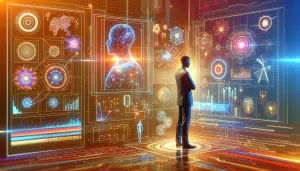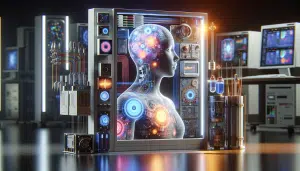AI Tools You Use Every Day Without Noticing
Ethan Harris November 1, 2025
Artificial intelligence shapes countless modern experiences, but many people overlook where it’s at play. This article uncovers how AI tools work in your daily life—spanning digital assistants, smart recommendations, home devices, and more. Explore key concepts and real examples of AI integration in technology people rely on every day.
AI in Everyday Digital Assistants
Digital assistants, like those embedded in smartphones or smart speakers, have made artificial intelligence a silent force in daily routines. When asking a device about the weather or to set a reminder, AI-powered natural language processing interprets your request. These assistants learn speech patterns, adjust to accents, and even suggest calendar events based on previous habits. The power behind these voice-activated helpers is machine learning, which constantly improves through user interactions. This technology personalizes experiences, making tasks more efficient for millions of users worldwide without them ever directly engaging with the underlying AI algorithms.
Chatbots on customer support websites represent another subtle form of AI integration. They help sort common queries, guide users toward resources, and sometimes resolve issues independently, reducing the need for human agents. These systems leverage advanced pattern recognition and conversational AI to deliver competent support instantly. By mining previous chat logs and user profiles, chatbots can even predict likely needs, making the entire process smoother for users and companies alike. This is just one way AI tools affect tasks once deemed entirely human-driven.
Even spelling and grammar checks on your devices have been revolutionized by AI. Beyond basic dictionary-based corrections, modern text editors scan sentence structure, word context, and tone. This ensures messages, emails, and documents achieve intended clarity and correctness by using neural networks trained on vast language datasets. People benefit from clearer, more professional communication every day, rarely realizing the AI that silently assists them. Subtle, yes—but these tools are always learning to anticipate and improve human language.
Smart Recommendations in Streaming and Shopping
Streaming platforms such as Netflix and Spotify rely heavily on AI-driven recommendation systems. When browsing shows, movies, or music, behind-the-scenes algorithms analyze your history—genres, favorites, searches, skips—to suggest what you might enjoy next. These models are continuously updated using collaborative filtering, clustering, and content-based filtering methods. Such AI tools increase user satisfaction and engagement by surfacing relevant or trending content that might otherwise go unnoticed. Smarter recommendations mean more personalized experiences, making digital entertainment seamless and enjoyable.
Online shopping platforms employ similar recommendation engines, but with a focus on buying patterns and preferences. Users get tailored product suggestions based on browsing behavior, past purchases, and even the time of day items are generally bought. Many retailers employ artificial intelligence to group customers with similar interests, provide dynamic search results, or highlight deals. These systems boost discoverability for shoppers while increasing retailers’ chances for successful sales. AI quietly shapes every product page and search result shown, optimizing the balance between user needs and business success.
Targeted advertising is another domain where AI quietly exerts influence. By tracking user actions across websites and apps, machine learning models profile preferences and habits. This allows marketers to personalize ads, increasing their relevance and appeal for each viewer. Interests, age brackets, and even subtle signals from browsing sessions help refine what is shown. While some may find this intrusive, responsible platforms use anonymized data and strict privacy measures. AI-powered recommendations support content discovery and commerce in ways that feel intuitive, keeping the experience engaging and productive for most users.
AI Enhancements in Smart Home Devices
Smart home devices are among the fastest-growing applications of AI. Thermostats, lights, cameras, and security systems often come with machine learning baked in. For example, thermostats observe routines and weather patterns, then adjust temperatures for optimal comfort and energy conservation. Lighting systems can gradually learn preferred brightness settings and automatically adjust based on time of day or presence in a room. Security cameras use vision-based AI to differentiate between people, packages, and animals, reducing false alerts and ensuring accurate notifications. These convenient features simplify tasks that would otherwise require constant human oversight.
Voice-activated home hubs bring comfort to the next level. These devices aggregate environmental data and user commands, harnessing AI to operate everything from appliances to locks. Over time, they understand when the coffee machine should power up or which music to play as dinner approaches. AI adapts to changes in household routines, improving energy management and security while helping users save time. As systems connect more seamlessly, they lay the groundwork for smarter, intuitive living spaces where essential functions anticipate needs without prompting.
Home health and wellness devices now integrate AI capabilities, too. Smart scales, monitoring systems, and sleep aids employ predictive analytics to offer personalized feedback and suggestions. This extends to wearable devices that track activity, sleep cycles, or heart rates. The constant collection and real-time analysis of sensor data help individuals develop healthier habits over time. Subtle and unobtrusive, these AI-driven devices provide feedback and encouragement that supports well-being without demanding attention—an invaluable benefit as technology and lifestyles become more interconnected.
Invisible AI in Navigation and Commuting
Navigation apps depend on sophisticated AI to provide real-time routes, avoid traffic jams, and suggest alternative paths. By aggregating live traffic feeds, historical travel data, and even input from other drivers, mapping services predict the quickest and safest paths. These dynamic systems also consider road closures, weather disruptions, and construction schedules, often updating recommendations as circumstances change. For millions, getting from point A to point B has become effortless thanks to AI’s ability to ‘see ahead’ and optimize travel experiences.
Ride-sharing apps exemplify how AI manages complex operations at massive scale. Matching passengers to drivers, balancing supply with fluctuating demand, and determining fair pricing all rely on predictive algorithms. These systems analyze rider trends, local events, and even the time of day to ensure wait times stay short. AI assists in keeping rideshare experiences efficient, cost-effective, and user-friendly. This technology is so deeply embedded that most users take its reliability and flexibility for granted.
Autonomous and driver-assist features in modern vehicles represent another layer of daily AI impact. Adaptive cruise control, automatic brakes, lane-keeping support, and parking assist are driven by real-time machine vision and sensor fusion. These tools improve safety, reduce driver fatigue, and signal a future of transportation where intelligent navigation is standard. As vehicles become even smarter, AI will remain central to enhancing convenience and reducing human error on the road.
Security and Spam Detection Powered by AI
Every email inbox and social platform is equipped with AI-powered filters designed to block spam, scams, and unwanted content. Machine learning models train on billions of messages to identify patterns and anomalies that suggest deceptive intent. These models continually adapt, learning from new online behaviors to stay ahead of increasingly sophisticated threats. The invisible guardians keep dangerous links, phishing attempts, and malicious attachments from reaching users. Most people never see the defensive measures working in the background—yet benefit daily from reduced risk and cleaner inboxes.
Biometric authentication, such as facial recognition and fingerprint scanning, utilizes AI to secure access to devices and applications. Deep learning models map unique patterns, improving accuracy and resisting spoofing attempts compared to simple PINs or passwords. These tools protect personal data while providing swift, frictionless access to technology. As digital security requirements grow more stringent, AI-driven authentication continues evolving to shield sensitive information from unauthorized use. The convenience and increased protection often go unnoticed until a breach is avoided.
Anti-fraud systems in banking and online payments further showcase AI’s critical role. These tools identify irregular spending patterns, block suspicious transactions, and alert users to potential compromises. By analyzing countless transactions in milliseconds, AI-driven systems help prevent financial losses and maintain trust in digital commerce. This is another sphere where daily interactions—shopping, banking, sharing—are safeguarded invisibly by powerful algorithms constantly evolving to counter new threats and ensure peace of mind for people everywhere.
The Future of Everyday AI Integration
AI technology continues advancing, with emerging tools set to become even more woven into daily life. From personalized learning platforms that adapt to student progress, to healthcare diagnostics offering tailored advice, the future is bright with AI-driven innovation. Developers and researchers now focus on making these systems more ethical, explainable, and user-friendly. Wider adoption means individuals of all backgrounds will encounter AI not just passively, but as an active aid in personal growth and well-being. This democratization of AI empowers more equitable access to technology’s benefits.
Sustainability is another key area where future AI can have profound impact. By optimizing energy use, reducing waste, and monitoring environmental conditions, AI helps create greener landscapes and more sustainable societies. Smart infrastructure, powered by AI, manages utilities and transit systems for efficiency. Even food production can become more resilient by leveraging predictive analytics to anticipate demand and optimize resources. As these technologies mature, communities around the world stand to gain from a smarter, more sustainable future.
Yet increased integration also raises new challenges. Individuals and organizations must grapple with questions of privacy, transparency, and algorithmic bias. Ethical frameworks and regulatory initiatives encourage the responsible development of AI, ensuring it serves society’s interests. Stakeholder input—from users to developers to governments—will shape this evolution. Looking ahead, understanding how invisible AI systems operate becomes as vital as experiencing their benefits, guiding everyone toward a balanced and informed relationship with technology.
References
1. OpenAI. (n.d.). How Language Models Like ChatGPT Work. Retrieved from https://openai.com/research/publications
2. National Institute of Standards and Technology. (n.d.). AI and Privacy. Retrieved from https://www.nist.gov/itl/ai-risk-management-framework
3. Cornell University. (n.d.). Recommendation Systems and Personalization. Retrieved from https://www.cs.cornell.edu/courses/cs4300/
4. U.S. Department of Energy. (n.d.). Artificial Intelligence for Smart Home Devices. Retrieved from https://www.energy.gov/eere/buildings/articles/smart-home-technologies-and-artificial-intelligence
5. European Union Agency for Cybersecurity. (n.d.). AI in Cybersecurity. Retrieved from https://www.enisa.europa.eu/topics/csirt-cert-services/guidelines-for-csirts/ai-in-cybersecurity
6. Stanford University. (n.d.). AI Index. Retrieved from https://aiindex.stanford.edu/report/







